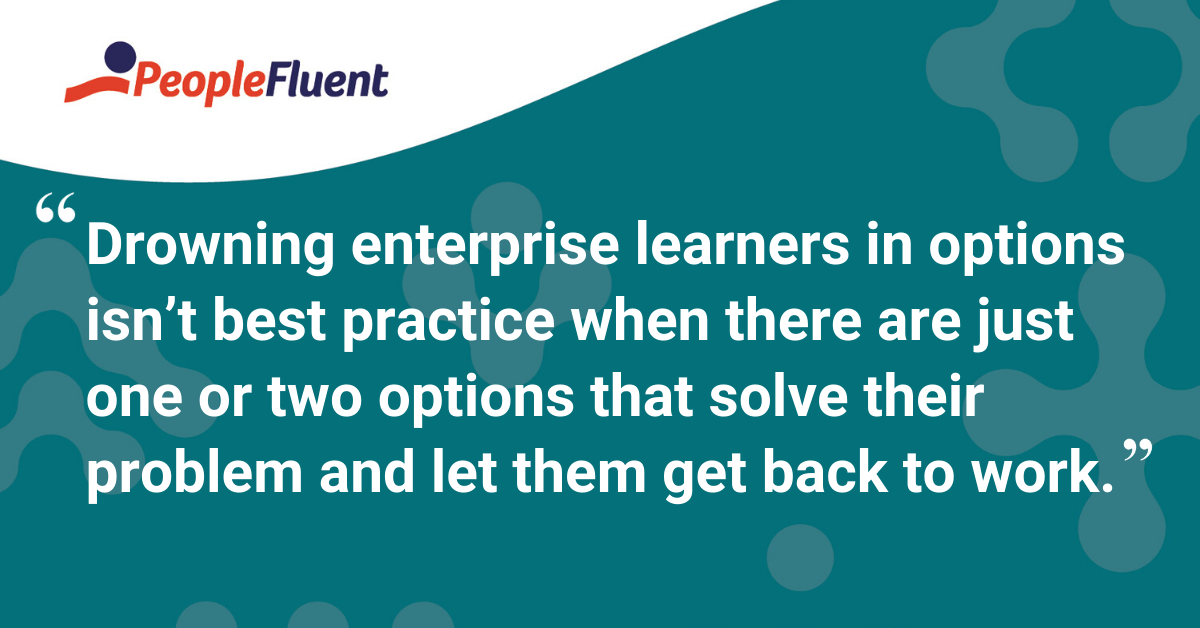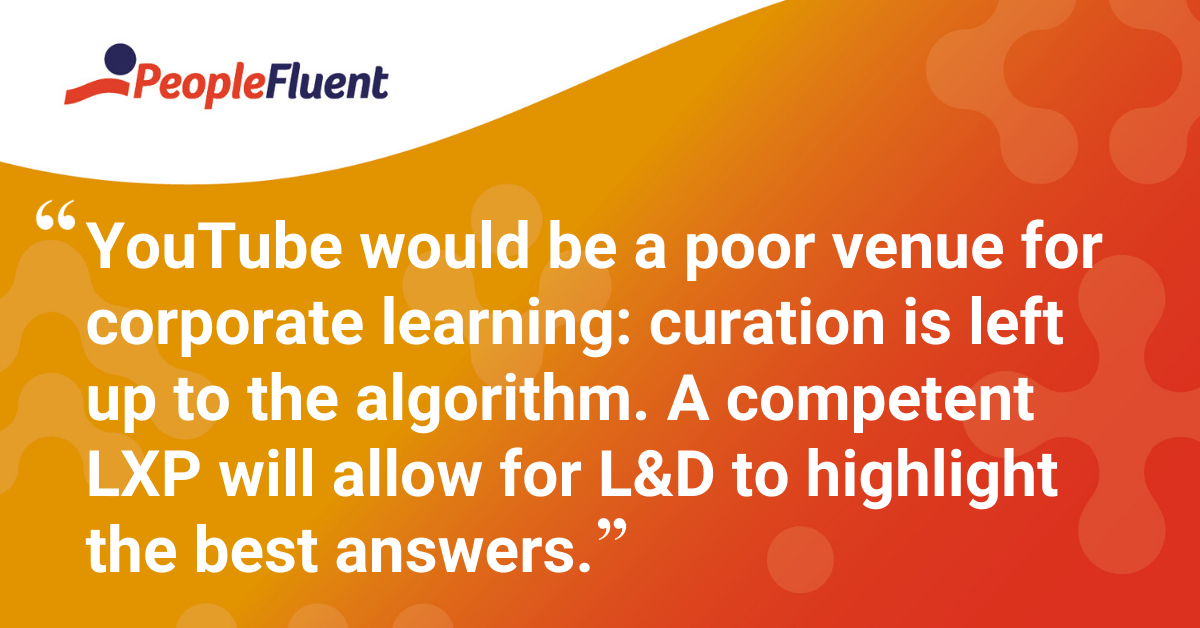Published: Feb 5, 2020Time to read: 8mins Category: Learning
5 Reasons Why the ‘Netflix of Learning’ May Be a Bad Idea
We recently caught up with Steve Goldberg, the principal Human Capital Management Industry Analyst and Advisor at Ventana Research to discuss the idea of ‘the Netflix of Learning’, a concept that demonstrates the limitations of ‘Learning Like We Live’ (while illustrating some of that theme’s strengths as well).
8-Track vs cassettes, VHS vs Betamax, Blu-ray vs HD DVD: the physical media format wars of yesterday seem like a quaint footnote to a world where streaming media currently reigns supreme. Netflix, Hulu, Amazon Prime, Apple TV+, Disney+, CBS All Access, HBO NOW and countless others do their macabre dance on the burial mound of discs, tapes and video rental stores we used to use. So it’s tempting to look to their example for our own future success in delivering and enabling corporate learning.
It’s healthy to have aspirations. And who wouldn’t want to build a product where content is enthusiastically consumed and the source of many a next-day watercooler chat. Learning Experience Platforms (LXPs) have been touted as the ‘Netflix of Learning’, invoking the current market leader in streaming entertainment. However, while LXPs are an important tool in the L&D toolkit, we’re not convinced that you actually need the ‘Netflix of Learning’.
In discussion with Steve Goldberg, we have drawn up a list of five reasons why you don’t need the ‘Netflix of Learning’.

1) You Mostly Like How it Looks
Netflix’s UI is an appealing and influential one. Harkening back to the shelves of the rental stores it replaced, its rows of high-resolution thumbnails vie for your attention. The typical thumbnail features nothing more than the title of the film, TV show or documentary and a face or two on a simple background. Select an item and it will draw you in with motion and trailers. At a glance, it promises an embarrassment of riches, tracks your progress through your current watchlist and markets new shows to you on its prominent main billboard.
There are definitely aspects of this design that translate well to a learning platform. Even without the production values of a film or TV studio, you can imagine being drawn into a learning resource with the same tactics. However, as Goldberg points out to us “The application of what you learn in a Netflix context is essentially random. It’s stored in the back of your head and if it ever becomes relevant it becomes relevant. Corporate learners usually have a specific goal of ‘I want to learn how to do x to achieve y’, it’s not something they want to keep in the back of their head.”
Furthermore, the reality is that organizations often lack the depth of content and a content-hungry audience that make the actual mechanisms behind Netflix’s design work.

2) You’re Not at the Movies
This is a point that’s best to get out of the way early, because though obvious, it’s easy to underplay. As Goldberg puts it, “Why do people watch Netflix? Primarily it’s to be entertained and enjoy themselves. You had a hard day at work or whatever and you want to escape, you want to be entertained; and on those occasions where you watched Netflix more to be informed, you likely wanted that experience to be enjoyable as well” Netflix is not there to make you a more productive worker. It’s not preparing you for compliance certification.
“Learning should be engaging and enjoyable” continues Goldberg, “that principle should be one of the pillars of your learning strategy. But enterprise learning’s main pillar should still be the practical application of learning for the purpose of enhancing your skill repertoire, progressing your career and creating new sources of value for your employer.”
More from the blog: '4 Ways Learning Technologies Can Boost Learner Engagement'
3) Your Learners Don’t Want to Be Overwhelmed
A learning designer’s goal should be to quickly provide answers that employees need without frustration or obstruction. Netflix’s approach is arguably to overwhelm viewers with hundreds of choices. There appears to be two reasons for this. Firstly, the streaming video market is a crowded one. Having more entertainment options than you actually need reassures you that you’ve picked the right service.
Secondly, despite the 158 million subscribers that Netflix boasts, its well-fed algorithm can only do so much to serve your whims and preferences. It needs to give you options to compensate for the fact that you will sometimes simply not be in the mood for what it views as logically the best viewing options for you. The needs of your enterprise learners are thankfully better defined. Drowning them in options isn’t best practice when there are just one or two options that solve their problem and let them get back to work.

4) You Don’t Have 158 Million Subscribers
Learning platforms will have to operate their recommendation engines on fundamentally different data. Netflix has the luxury of being able to build user recommendations by comparing the habits of 158 million subscribers. This user base will watch many more titles and many more hours of content than a corporate learner will. Recommendations may also come from other subscribers on social platforms or in everyday life.
Even in the largest organizations, learning platforms will have far fewer eyeballs on their content. On the other hand, the problem of what a person in a certain job or role needs to see is comparatively easy to build for. Engagement metrics can be part of the equation, but they should be used with caution. After all, compliance content is likely to be widely consumed by any user database. Instead, job roles, filters, categories, and curation can help to reach the goal of showing an appropriate number of potential answers.
5) YouTube Is Likely a Better (But Still Not Optimal) Way to Go
In many ways YouTube is a much better model overall than Netflix. In fact, the reason we’re not enthusiastically touting learning platforms as the “YouTube of Learning” is because YouTube is already the “YouTube of Learning.” From plumbing and knitting to computer hardware, there’s usually a concise, microlearning-style answer to your query. A high amount of YouTube’s content is authored by digital natives (in a 2019 Ofcom study, 65% of the top 100 YouTube channels were found to not belong to traditional media organizations). LXPs are similarly using user-generated content to leverage the expertise of ‘natives’ in the field, doing the work.
Despite this, YouTube would be a poor venue for corporate learning. For any given ‘how to’ query, there may be several videos vying for your attention—sometimes with contradictory information. Curation is left up to the algorithm. Sophisticated as it is, it still leaves the elevation of the best possible answer up to a degree of chance. A competent LXP will allow for L&D to highlight the best answers.
Goldberg elaborates on why this is so important “In an enterprise, you have finite resources. You don’t want the positive, beneficial experience to be a function of good fortune. You want it to be predictable, engaging and enjoyable and it needs to have a practical benefit as quickly as possible.”
YouTube is also an entertainment platform, and the goal of distraction is never far away. Autoplay, adverts and a lengthy list of recommended videos exist to ensure that you’re less likely to get back to the task you came to find information on. Then as Goldberg notes, there’s the inevitability of such content withholding answers: “YouTube creators are rarely just being philanthropic, they want to earn some money too. How many of us have ever diligently read or watched something in full, only to be told that what we’re actually looking for isn’t actually available until we take some further action? That kind of content is built to keep you engaged and to lead you towards taking action that will benefit some other entity”.

But…
When stakeholders, SMEs and learners say they want a corporate Netflix, learning professionals shouldn’t be dismissive. Instead, they need to reframe the discussion: ask what aspects of the Netflix-like experience they’re after. LXPs can offer similar visuals and a similar approach to content recommendation.
Only then can we start helping them understand the work required to get the most out of an LXP and how they will need to invest in a content structure that fits the organization. L&D, HR and compliance can then curate learning paths that make it clear where to start and progress.
A version of this post originally appeared on the Instilled blog.
Discover How Learning Builds Skills and Ensures Compliance
Design, deploy, track, analyze, and report on enterprise learning and compliance programs. PeopleFluent helps you execute your programs seamlessly, so employees upgrade their skills and you get results.